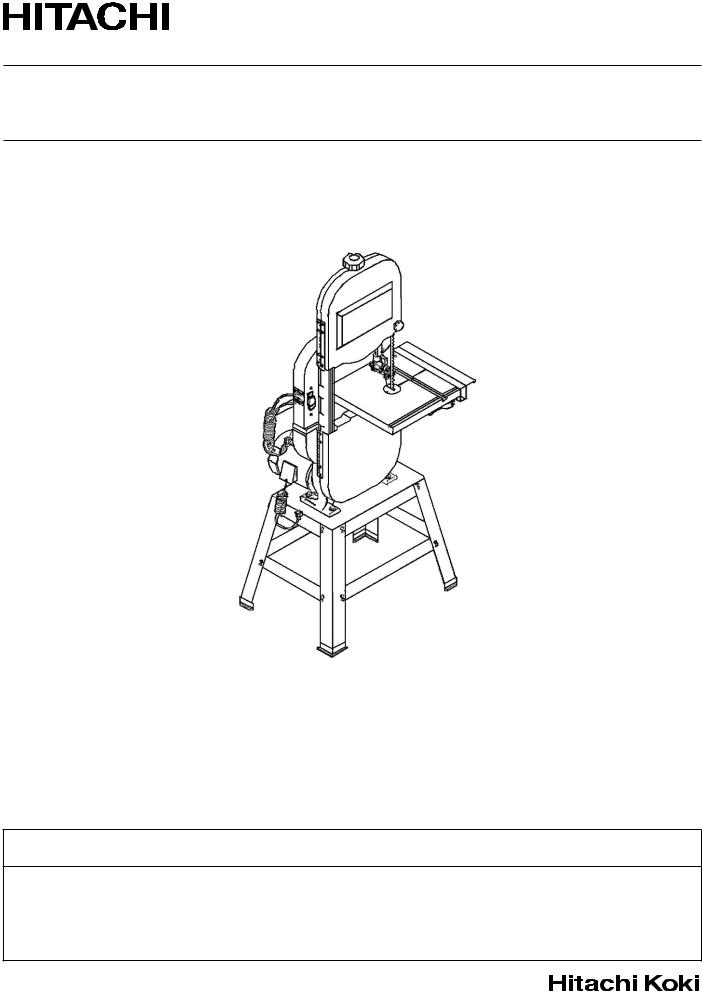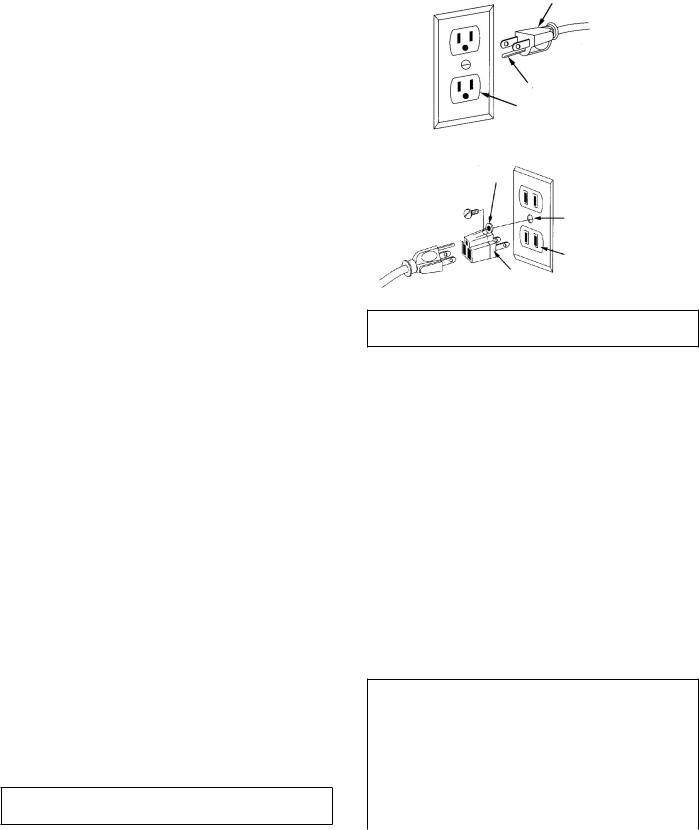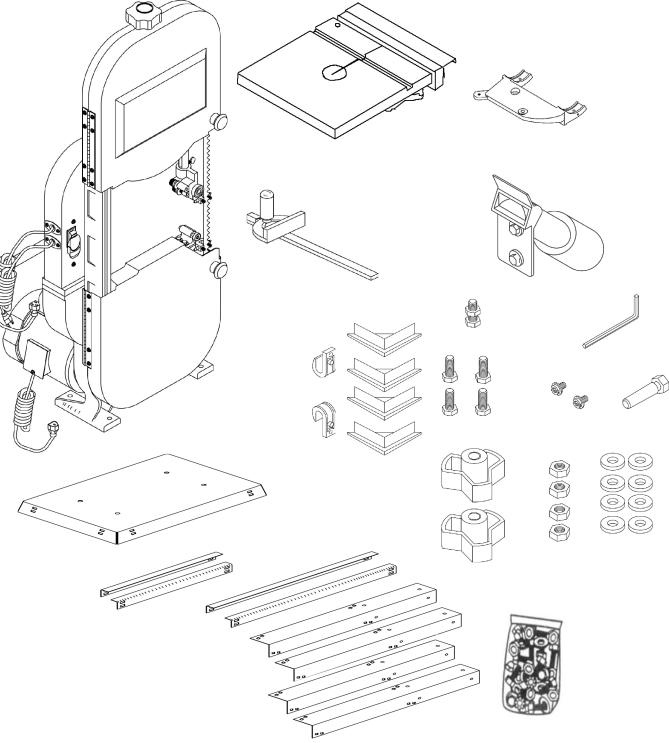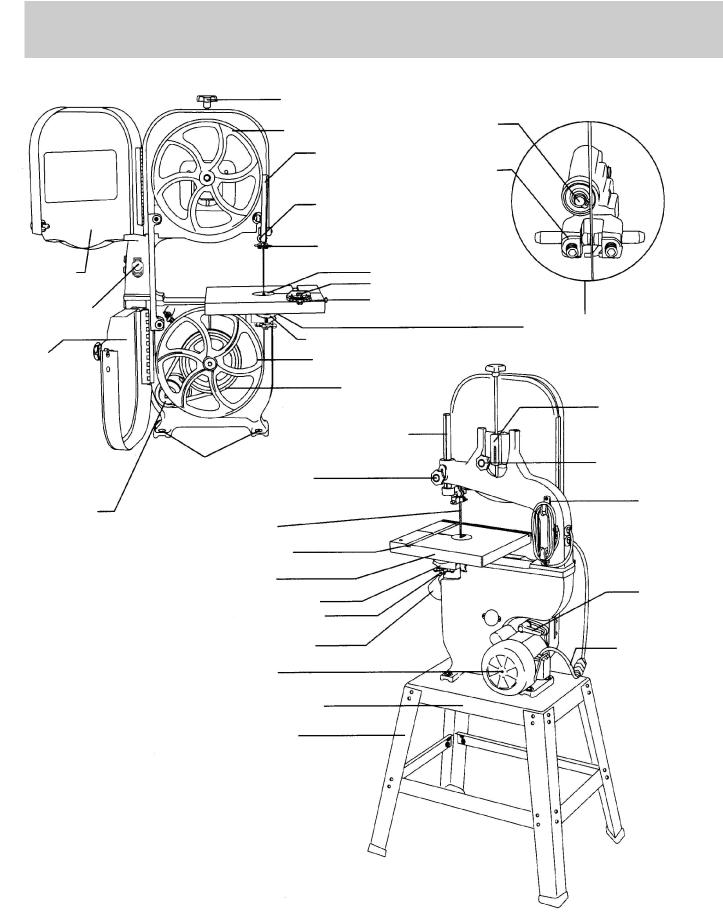Hitachi CB 13F User Manual

Model |
CB 13F |
Band Saw
INSTRUCTION MANUAL AND SAFETY INSTRUCTIONS
 WARNING
WARNING
Improper and unsafe use of this power tool can result in death or serious bodily injury!
This manual contains important information about product safety. Please read and understand this manual before operating the power tool. Please keep this manual available for others before they use the power tool.

TABLE OF CONTENTS
SECTION |
Page |
SECTION |
Page |
Products Specifications .......................................................... |
3 |
Assembly and Adjustments |
.................................................11 |
Safety ...................................................................................... |
4 |
Operation ............................................................................... |
17 |
Accessories and Attachments ............................................... |
7 |
Maintenance .......................................................................... |
20 |
Carton Contents ..................................................................... |
7 |
Troubleshooting Guide ......................................................... |
21 |
Know Your Band Saw ............................................................ |
9 |
Parts List ................................................................................ |
23 |
Glossary of Terms ................................................................. |
10 |
|
|
HITACHI AUTHORIZED SERVICE CENTERS
Service under this warranty is available from Hitachi Koki U.S.A., Ltd. at :
IN THE U.S.A. |
IN CANADA |
3950 Steve Reynolds Blvd. Norcross, GA 30093
9409 Owensmouth Ave. Chatsworth, CA 91311
OR CALL: (800) 546-1666 for a service center nearest you.
6395 Kestrel Road Mississauga, ON L5T 1Z5
OR CALL: (800) 970-2299 for a service center nearest you.
— 2 —

 WARNING
WARNING
Some dust created by power sanding, sawing, grinding, drilling and other construction activities contains chemicals known to the state of California to cause cancer, birth defects or other reproductive harm. Some examples of these chemicals are:
•Lead from lead-based paints
•Crystalline silica from bricks, cement and other masonry products
•Arsenic and chromium from chemically treated lumber
Your risk from these exposures varies, depending on how often you do this type of work. To reduce your exposure to these chemicals, work in a well-ventilated area and work with approved safety equipment such as dust masks that are specially designed to filter out microscopic particles.
PRODUCT SPECIFICATIONS
MOTOR |
|
Power source ........................ |
120 V, AC, 60 HZ, 7AMPS. |
Speeds Low .......................... |
1410 F.P.M |
|
(Feet per minute) |
High ......................... |
2600 F.P.M |
Horsepower .......................... |
1HP(Max. Developed) |
DRIVE BELT |
A 26 |
Cutting Capacity |
|
Throat .................................... |
12” |
Height .................................... |
5” |
Blade |
|
Width ..................................... |
1/8”, 1/4”, 3/8”, 1/2” |
Length ................................... |
80” |
Table |
|
Size ........................................ |
13” x 13” |
Tilt .......................................... |
0° Left –– 45° Right |
DUST COLLECTION....................... |
Yes |
NET WEIGHT.................................. |
145.5 LB (66.0Kg.) |
 WARNING
WARNING
To avoid electrical hazards, fire hazards, or damage to the tool, use proper circuit protection.
Use a separate electrical circuit for your tools.
Your Band Saw is wired at the factory for 120V operation. Connect to a 120V, 15 AMP branch circuit and use a 15 Amp time delay fuse or circuit breaker. To avoid shock or fire, replace power cord immediately if it is worn, cut or damaged in any way.
— 3 —

SAFETY
GENERAL SAFETY INSTRUCTIONS
BEFORE USING THE BAND SAW
Safety is a combination of common sense, staying alert and knowing how to use this Band Saw.
 WARNING
WARNING
To avoid mistakes that could cause serious injury, do not plug the Band Saw in until you have read and understood the following:
1.READ and become familiar with the entire Operator’s Manual. LEARN the tool’s application, limitations and possible hazards.
2.KEEP GUARDS IN PLACE and in working order.
3.REMOVE ADJUSTING KEYS AND WRENCHES.
Form the habit of checking to see that keys and adjusting wrenches are removed from the tool before turning ON.
4.KEEP WORK AREA CLEAN. Cluttered areas and benches invite accidents.
5.DON’T USE IN DANGEROUS ENVIRONMENT.
Don’t use power tools in damp or wet locations, or expose them to rain. Keep work area well lighted.
6.KEEP CHILDREN AWAY. All visitors should be kept a safe distance from work area.
7.MAKE WORKSHOP CHILD PROOF with padlocks, master switches, or by removing starter keys.
8.DON’T FORCE THE TOOL. It will do the job better and safer at the rate for which it was designed.
9.USE THE RIGHT TOOL. Do not force tool or attachment to do a job for which it was not designed.
10.USE PROPER EXTENSION CORD. Make sure your extension cord is in good condition. When using an extension cord, be sure to use one heavy enough to carry the current your product will draw. An undersized cord will result in a drop in line voltage and in loss of power that will cause the tool to overheat. The table on page 7 shows the correct size to use depending on cord length and nameplate ampere rating. If in doubt, use the next heavier gauge. The smaller the gauge number, the heavier the cord.
11.WEAR PROPER APPAREL. Do not wear loose clothing, gloves, neckties, rings, bracelets, or other jewelry that may get caught in moving parts. Non-slip footwear is recommended. Wear protective hair covering to contain long hair.
12.ALWAYS WEAR EYE PROTECTION. Any Band Saw can throw foreign objects into the eyes that could cause permanent eye damage. ALWAYS wear Safety Goggles (not glasses) that comply with ANSI Safety standard Z87.1 Everyday eyeglasses have only impact–resistance lenses. They ARE NOT safety glasses. Safety Goggles are available at HITACHI. NOTE: Glasses or goggles not in compliance with ANSI Z87.1 could cause serious injury.
13.WEAR A FACE MASK OR DUST MASK. Sawing operation produces dust.
14.SECURE WORK. Use clamps or a vise to hold work when practical. It’s safer than using your hand and it frees both hands to operate tool.
15.DISCONNECT TOOLS before servicing; when changing accessories such as blades, bits, cutters, and the like.
16.REDUCE THE RISK OF UNINTENTIONAL STARTING.
Make sure switch is in OFF position before plugging in.
17.USE RECOMMENDED ACCESSORIES. Consult the Operator’s Manual for recommended accessories. The use of improper accessories may cause serious injury.
18.NEVER STAND ON TOOL. Serious injury could occur if the tool is tipped or if the cutting tool is unintentionally contacted.
19.CHECK FOR DAMAGED PARTS. Before further use of the tool, a guard or other part that is damaged should be carefully checked to determine that it will operate properly and perform its intended function – check for alignment of moving parts, binding of moving parts, breakage of parts, mounting, and any other conditions that may affect its operation. A guard or other part that is damaged should be properly repaired or replaced.
20.NEVER LEAVE TOOL RUNNING UNATTENDED. TURN POWER “OFF”. Don’t leave tool until it comes to a complete stop.
21.DON'T OVERREACH. Keep proper footing and balance at all times.
22.MAINTAIN TOOLS WITH CARE. Keep tools sharp and clean for best and safest performance. Follow instructions for lubricating and changing accessories.
23.DO NOT use power tools in the presence of flammable liquids or gases.
— 4 —

24.DO NOT OPERATE the tool if you are under the influence of any drugs, alcohol or medication that could affect your ability to use the tool properly.
25.ALWAYS operate the band saw in a well-ventilated area and provide for proper dust removal. Use dust collection systems whenever possible. Dust generated from certain materials can be hazardous to your health.
SPECIFIC SAFETY INSTRUCTIONS FOR BAND SAWS
1.TO AVOID INJURY from unexpected movement, make sure the saw is on a firm, level surface, properly secured to prevent rocking. Make sure there is adequate space for operating. Bolt the saw to a support surface to prevent slipping, walking, or sliding during operation.
2.TURN the saw OFF and unplug the saw before moving it.
3.USE THE CORRECT size and style of blade.
4.USE blades rated at 2700 FPM or greater.
5.MAKE SURE the blade teeth point down and towards the table.
6.BLADE GUIDES, SUPPORT BEARINGS, AND BLADE TENSION must be properly adjusted to avoid accidental blade contact and to minimize blade breakage. To maximize blade support, always adjust the upper blade guide and blade guard so that it is 1/8 inch above the work-piece.
7.TABLE LOCK HANDLE should be tight.
8.USE EXTRA CAUTION with large, very small or awkward work-pieces.
9.USE EXTRA SUPPORTS to prevent work-pieces from sliding off the table top. Never use another person to support the work-piece.
10.WORK-PIECES must be secured so they don’t twist, rock, or slip while being cut.
11.PLAN intricate and small work carefully to avoid pinching the blade. Avoid awkward operation and hand positions to prevent accidental contact with the blade.
12.SMALL PIECES should be secured with jigs or fixtures. Do not hand hold pieces that are so small your fingers are under the blade guard.
13.SUPPORT round work properly (with a V-block or clamped to the miter gauge) to prevent it from rolling and the blade from biting.
14.CUT only one work-piece at a time. Make sure the table is clear of everything except the work-piece and its guides before you turn the saw on.
15.ALWAYS WATCH the saw run before each use. If there is excessive vibration or unusual noise, stop immediately. Turn the saw OFF. Unplug it immediately. Do not start the saw again until the problem has been located and corrected.
16.TO FREE any jammed material, turn the switch OFF. Remove the switch key and unplug the saw. Wait for all moving parts to stop before removing jammed material.
17.DON’T LEAVE the work area until all moving parts are stopped. To child-proof the workshop, shut OFF the power to master switches and remove the switch key from the band saw. Store it in a safe place, away from children.
 WARNING
WARNING
For your own safety, read the entire instruction manual before operating the band saw.
1.Wear eye protection.
2.Do not wear gloves, necktie, or loose clothing.
3.Make sure the saw is on a firm level surface and properly secured.
4.USE ONLY THE RECOMMENDED ACCESSORIES.
5.Use extra caution with very large, very small, or awkward work-pieces.
6.Keep hands away from the blade at all times to prevent accidental injury.
7.Do not remove jammed cutoff pieces until the blade has stopped.
8.Maintain proper adjustment of blade tension, blade guides and thrust bearings.
9.Adjust upper guide to just clear the work-piece.
10.Hold the work-piece firmly against the table.
ELECTRICAL REQUIREMENTS
POWER SUPPLY AND MOTOR SPECIFICATIONS
 WARNING
WARNING
To avoid electrical hazards, fire hazards, or damage to the tool, use proper circuit protection. Use a separate electrical circuit for your tools. Your saw is wired at the factory for 120V operation. Connect to a 120V, 15 Amp circuit and use a 15 Amp time delay fuse or circuit breaker. To avoid shock or fire, if power cord is worn or cut, or damaged in any way, have it replaced immediately.
GROUNDING INSTRUCTIONS
 WARNING
WARNING
This tool must be grounded while in use to protect the operator from electrical shock.
— 5 —

IN THE EVENT OF A MALFUNCTION OR BREAKDOWN, grounding provides a path of least resistance for electric current and reduces the risk of electric shock. T his tool is equipped with an electric cord that has an equipmentgrounding conductor and a grounding plug. T he plug
M U S T be plugged into a matching receptacle that is properly installed and grounded in accordance with ALL local codes and ordinances .
DO NOT MODIFY THE PLUG PROVIDED. If it will not fit the receptacle, have the proper receptacle installed by a qualified electrician.
IMPROPER CONNECTION of the equipment-grounding conductor can result in risk of electric shock. T he conductor with green insulation (with or without yellow stripes) is the equipment-grounding conductor. If repair or replacement of the electric cord or plug is necessary, DO N OT connect the equipment-grounding conductor to a live terminal.
CHECK with a qualified electrician or service person if you do not completely understand the grounding instructions, or if you are not sure the tool is properly grounded.
USE ONLY 3-wire extension cords that have 3-prong grounding plugs and 3-pole receptacles that accept the tool's plug. Repair or replace damaged or worn cord immediately.
U se a separate electrical circuit for your tools . T his circuit must not be less than # 12 wire and should be protected with a 15 Amp time delay fuse. B efore connecting the motor to the power line, make sure the switch is in the OFF position and the electric current is rated the same as the current stamped on the motor nameplate. R unning at a lower voltage will damage the motor.
T his tool is intended for use on a circuit that has a receptacle like the one illustrated in Figure A .
shows a 3-prong electrical plug and receptacle that has a grounding conductor. If a properly grounded receptacle is not available, an adapter (Figure B ) can be used to temporarily connect this plug to a 2-contact ungrounded receptacle. The adapter (Figure B ) has a rigid lug extending from it that M U S T be connected to a permanent earth ground, such as a properly grounded receptacle box.
T HE T E N POR AR Y ADAPT E R S HOU LD B E U S E D ON LY U N T IL A PR OPE R G R OU N DE D PU T LE T CAN B E
IN S T ALLE D B Y A QU ALIFIE D E LE CT R ICIAN . T he Canadian E lectrical Code prohibits the use of adapters .
CAUTION: In all cases, make certain the receptacle is properly grounded. If you are not sure, have a qualified electrician check the receptacle.
 WARNING
WARNING
T his tool is for indoor use only. Do not expose to rain or use in damp locations .
Fig. A
3-Prong Plug
G rounding Prong
Properly G rounded 3-Prong R eceptacle
Fig. B
G rounding Lug
M ake S ure T his is Connected to a K nown G round
2-Prong
R eceptacle
Adapter
 WARNING
WARNING
T his band saw is for indoor use only. Do not expose to rain or use in damp locations
GUIDELINES FOR EXTENSION CORDS
USE PROPER EXTENSION CORD. M ake sure your extension cord is in good condition. W hen using an extension cord, be sure to use one heavy enough to carry the current your product will draw. An undersized cord will cause a drop in line voltage, resulting in loss of power and cause overheating. T he table below shows the correct size to use depending on cord length and nameplate ampere rating. If in doubt, use the next heavier gauge.
T he smaller the gauge number the heavier the cord.
Be sure your extension cord is properly wired and in good condition. Always replace a damaged extension cord or have it repaired by a qualified person before using it. Protect your extension cords from sharp objects, excessive heat and damp or wet areas .
MINIMUM GAUGE FOR EXTENSION CORDS (AWG) (When using 120 Volt only)
Ampere R ating |
|
T otal length in feet |
|
||||
|
|
|
|
|
|
|
|
|
N ot |
|
|
|
|
|
|
M ore T han |
M ore T han |
25' |
|
50' |
100' |
|
150' |
0 |
6 |
18 |
|
16 |
16 |
|
14 |
6 |
10 |
18 |
|
16 |
14 |
|
12 |
10 |
12 |
16 |
|
16 |
14 |
|
12 |
12 |
16 |
14 |
|
12 |
N ot Applicable |
||
— 6 —

ACCESSORIES AND ATTACHMENTS
RECOMMENDED ACCESSORIES
 WARNING
WARNING
To avoid injury:
Use only accessories recommended for this band saw.
Follow instructions that accompany accessories. Use of improper accessories may cause hazards.
Use only accessories designed for this band saw to avoid injury from thrown broken parts or workpieces.
Do not use any accessory unless you have completely read the instruction or operator’s manual for that accessory.
ITEM
Blade width: 1/8”,1/4”,3/8”,1/2”
Blade length: 80”
CARTON CONTENTS
UNPACKING AND CHECKING CONTENTS
Carefully unpack the band saw and all its parts, and compare against the illustration following. Place the saw on a secure surface and examine it carefully.
 WARNING
WARNING
To avoid injury from unexpected starting, do not plug the power cord into a power source receptacle during unpacking and assembly. This cord must remain unplugged whenever you are assembling or adjusting the saw.
Although compact, this saw is heavy. To avoid back injury, get help whenever you have to lift the saw.
If any part is missing or damaged, do not plug the band saw in until the missing or damaged part is replaced, and assembly is complete.
TABLE OF LOOSE PARTS
ITEM |
DESCRIPTION |
QUANTITY |
BAND SAW: |
|
|
A. |
Band saw with motor |
1 |
B. |
Table with extension wing |
1 |
C. |
Trunnion support bracket |
1 |
D. |
Miter gauge |
1 |
E. |
Sawdust port |
1 |
F. |
Power cord hooks |
2 |
|
Foot pads |
4 |
G. |
Hex. Bolt & nuts |
1 |
H. |
Hex. Bolt |
4 |
I. |
Knobs |
2 |
J. |
Hex. Key |
1 |
K. |
Screws |
2 |
L. |
Long hex. Bolt |
1 |
M. |
Hex. Nuts |
4 |
N. |
Large washers |
8 |
LEG STAND: |
|
|
O. |
Leg stand top plate |
1 |
P. |
Short lower brackets |
2 |
Q. |
Long lower brackets |
2 |
R. |
Legs |
4 |
S. |
Bag: |
|
|
Carriage bolts |
32 |
|
Hex. Nuts |
32 |
|
Washers |
32 |
— 7 —

UNPACKING YOUR BAND SAW
B
C
D |
|
E |
|
G |
|
|
|
J |
|
H |
|
A |
K |
L |
|
F |
|
|
I |
|
O |
M |
N |
|
||
|
|
|
P |
|
|
Q |
|
|
R |
|
|
|
|
S |
— 8 —

Upper cover
ON/OFF switch
Lower cover
Motor pulley
KNOW YOUR BAND SAW
Blade tension knob |
|
Upper blade wheel |
Lower blade |
support bearing |
Blade guard
Lower blade guide
Upper blade support bearing
Upper blade guide
Table insert
Miter gauge
Table aligning pin
Tilt bevel scale
Lower blade wheel
V-Belt
Upper blade
guide rod
Mounting holes
Upper blade guide lock knob
Blade
Miter slot
Table
Table trunnion
Table lock plate
Sawdust port
Motor
Stand top table
Leg stand
Table removed for clarity of illustration
Blade tension gauge
Blade tracking knob
Power cord wrap
V-Belt tension lock
Motor cord
— 9 —
